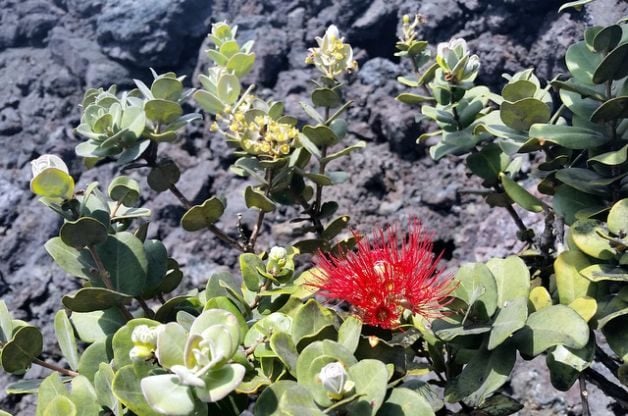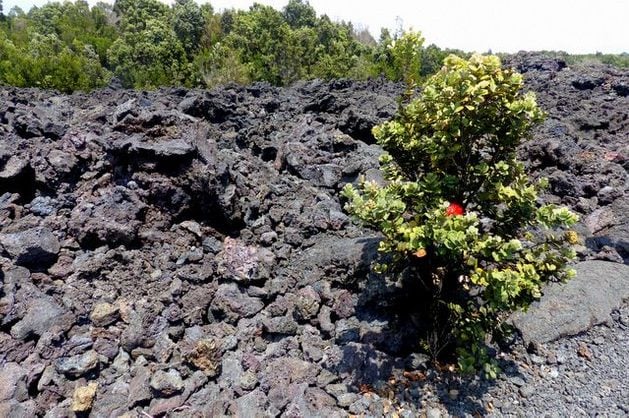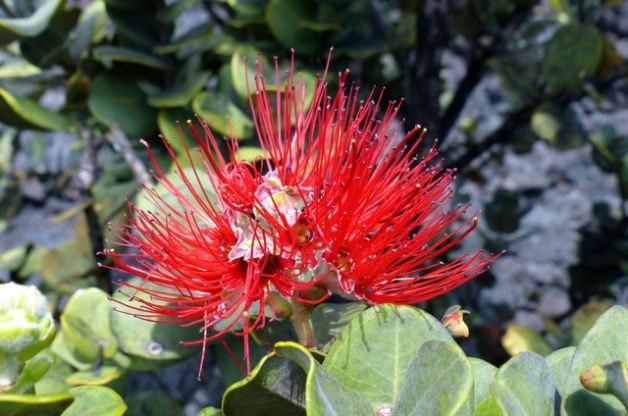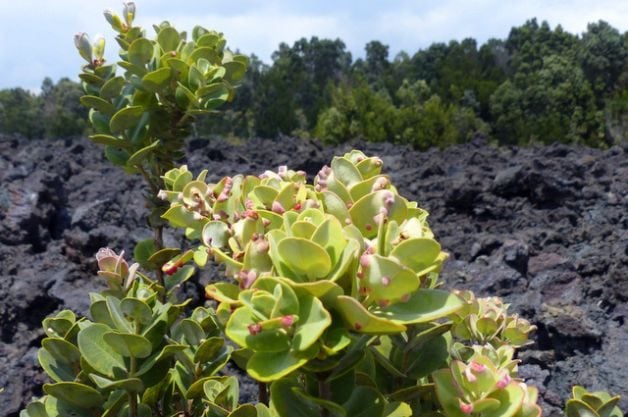Ohia Lehua, a Legendary Plant of Hawaii
Updated: Apr. 24, 2020
Sacred to Pele, colonizer of lava flows, and backed by a beautiful legend of lovers, Ohia Lehua is one of Hawaii's most beloved plants.
The power of a volcano is undeniable. Whether by explosive forces or slow but inevitable flows, the fires and molten lava destroy anything in their path. Standing on a hardened lava flow on the Big Island of Hawaii, you feel as if nothing could ever grow there again. You’d be wrong, though. As with most places on Earth, life finds a way, and the ohia lehua barely waits for the lava to cool before finding its way to prosper almost directly on the basalt rock.

Ohia lehua (Metrosideros polymorpha) is endemic to the six largest islands in Hawaii, where it can be seen just about anywhere up to 8200 feet above sea level. It’s a tough plant, part of the Myrtle family, and well-adapted to its environment. In difficult (or almost no) soils, like former lava flows, it’s a twisted shrub struggling to grow in what seem to be impossible conditions. In richer soils, it can become a tree nearly 100 feet tall. Either way, the small ovoid leaves are accented by powder-puff-like flowers, usually red but ranging to oranges and yellows as well. The blooms are heaviest in spring, but can appear throughout the year.

Pronounced “o-HEE-ah lay-HOO-ah” and properly spelled ʻōhiʻa lehua in the Hawaiian language, this plant has inspired a beautiful legend of steadfast lovers. Hawaiians love to “talk story,” and nearly any resident of the islands can tell you of the jealous goddess Pele, who spotted the handsome man ʻŌhiʻa working in the forests one day and immediately took a fancy to him. Unfortunately for Pele, ʻŌhiʻa was already in love himself, with the delicately beautiful Lehua. He politely ignored Pele’s advances, infuriating the goddess. In her anger, and before Lehua’s eyes, she turned him into a twisted gnarled tree and vanished. Lehua, devestated, turned to the other gods for assistance in restoring her beloved ʻŌhiʻa to her, but Pele’s power was too strong to overcome. Instead, the gods turned Lehua herself into a lovely red flower and set her upon the tree, reunited with her love. Hawaiian legend says that as long as the flower remains on the tree, the weather will be sunny and fair, but if a flower is plucked, the skies will fill with rain, tears of the lovers once again parted.

Beyond the legend, ohia lehua has had many uses for native Hawaiians. The wood was used to build houses and fences, create the seats and decks of their famous canoes, and burned as firewood. It is one of the few honey plants native to Hawaii, and the honey made from its flowers has a subtle floral taste. The flowers of this plant have long been used for traditional leis worn during performances by those performing the hula. Sticks made of the wood, called kalaau, are used in the dance as well.

Perhaps most importantly, ohia lehua is often the first plant to colonize lava flows, bringing areas that seem dead back to life. The shrub shown in these pictures is growing on a lava flow that was active a scant 40 years ago. Much of the area remains barren, but the ohia lehua grows here and there, helping to break the basalt rock down into soil that other plants will later find and use. This plant has deep roots in Hawaiian nature and culture, and understanding more about it helps a visitor to Hawaii understand more about life there as well.
NOTE: In the last couple of years, a new disease called Rapid Ohia Death has been spreading among the forests and residential areas of the Big Island of Hawaii. Learn more about it, and efforts to combat it, by clicking here.